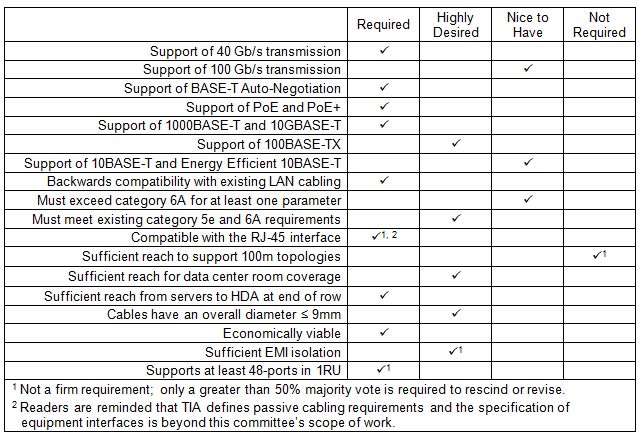Will we see a standard for 40 Gigabit Ethernet over twisted-pair copper cabling?
Q: Will we see a standard for 40 Gigabit Ethernet over twisted-pair copper cabling and does the fact that ISO/IEC and the TIA are investigating the requirements for achieving this increase the possibility of it happening?
A: Yes and yes! There are very strong indicators that development of a greater than 10Gbps Ethernet application for balanced twisted-pair cabling will begin in 2012. These include:
1) the availability of IEEE 802.3ba compliant 40Gbps Ethernet computer backplanes,
2) the availability of IEEE 802.3ba compliant 40Gbps and 100Gbps Ethernet multimode and singlemode optical fiber network gear, and
3) new work projects initiated by ISO/IEC and TIA to develop specifications for 100Ω Next Generation balanced twisted-pair cabling.
While it is likely that the IEEE 802.3 Ethernet Working Group will engineer this new twisted-pair Ethernet specification, there are no formally adopted objectives or specifications for a greater than 10Gbps Ethernet application at this time. However, the indicators above provide significant clues regarding the characteristics of a greater than 10Gbps application and the cabling that will support it.
Because Ethernet applications for the LAN backbone and data center core have always preceded Ethernet specifications for the LAN horizontal and data center edge, it is a good bet that the next Ethernet over balanced twisted-pair speed will be 40Gbps. At this time, the biggest driver demonstrating the great industry commitment to, interest in, and investment in the future of copper-based Ethernet is the work that is being done by ISO/IEC and TIA to develop Next Generation Cabling specifications.
ISO/IEC recently initiated a project to develop a new Standard tentatively entitled, “ISO/IEC 11801-99-x Guidance for balanced cabling in support of at least 40 GBit/s data transmission”. This proposed 2 part Standard will address capabilities of both existing ISO/IEC 11801 compliant channels and channels with extended and/or enhanced performance characteristics. TIA is currently working on a project to develop “Specifications for 100Ω Next Generation Cabling”, which is anticipated to be published as addendum 1 to ANSI/TIA-568-C.2. From the efforts of these two groups, we can already surmise that next generation cabling supporting 40Gbps transmission will require at least 1GHz of bandwidth, be backwards compatible with existing Ethernet applications, and potentially drive the need for a new reduced length (i.e. less than 100 meter) topology specifically supporting data center deployments.


